Distance MERCEDES-BENZ S-Class 2015 W222 Owner's Manual
[x] Cancel search | Manufacturer: MERCEDES-BENZ, Model Year: 2015, Model line: S-Class, Model: MERCEDES-BENZ S-Class 2015 W222Pages: 502, PDF Size: 9.59 MB
Page 10 of 502
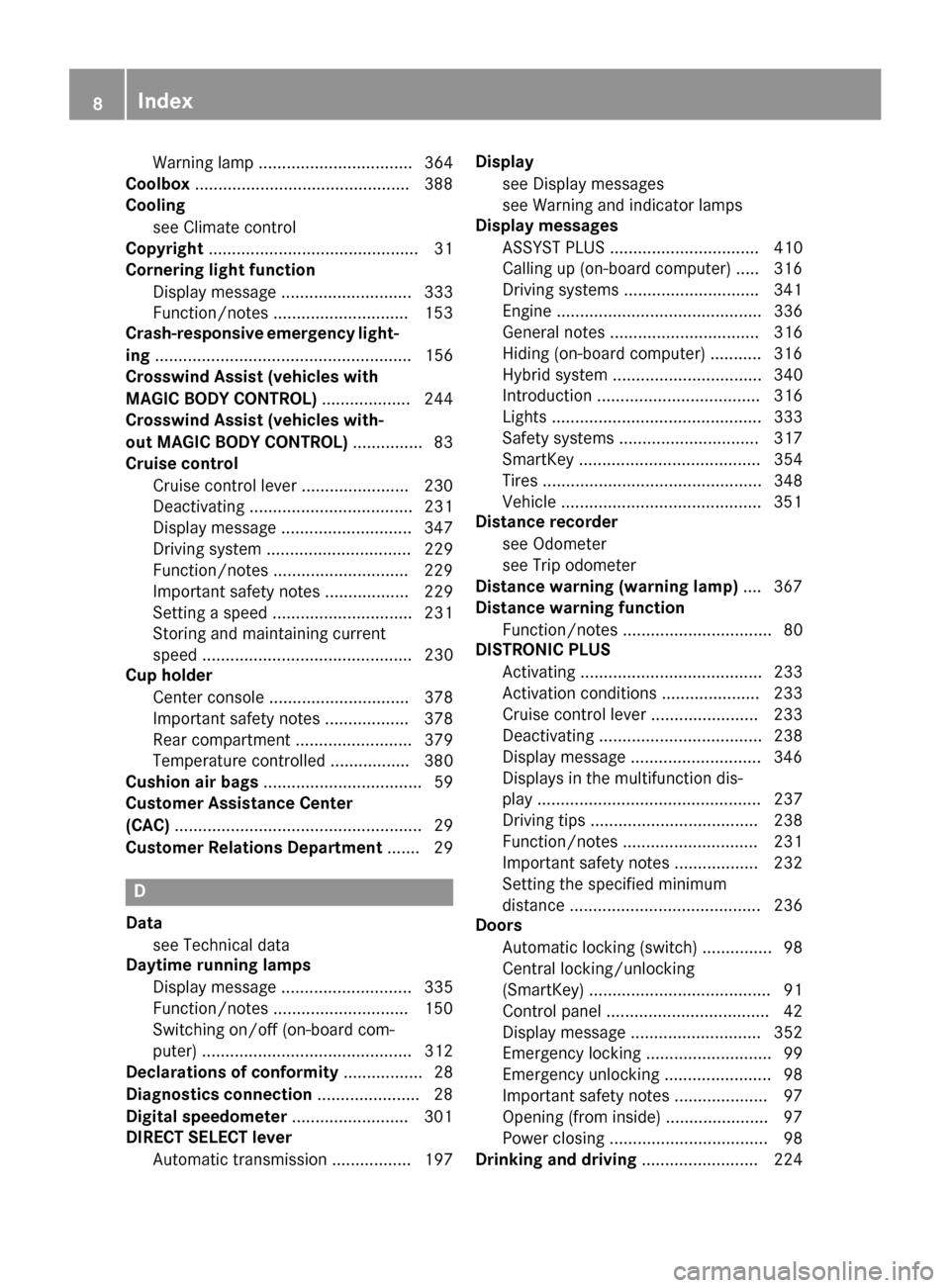
Warning lamp ................................. 364
Coolbox ..............................................3 88
Cooling
see Climate control
Copyright ............................................. 31
Cornering light function
Display message ............................ 333
Function/notes ............................ .153
Crash-responsive emergency light-
ing ....................................................... 156
Crosswind Assist (vehicles with
MAGIC BODY CONTROL) ................... 244
Crosswind Assist (vehicles with-
out MAGIC BODY CONTROL) ...............83
Cruise control
Cruise control leve r .......................230
Deactivating ................................... 231
Display message ............................ 347
Driving system ............................... 229
Function/notes ............................ .229
Important safety notes .................. 229
Setting a speed .............................. 231
Storing and maintaining current
speed ............................................. 230
Cup holder
Center console .............................. 378
Important safety notes .................. 378
Rear compartment ......................... 379
Temperature controlled ................. 380
Cushion air bags .................................. 59
Customer Assistance Center
(CAC) ..................................................... 29
Customer Relations Department ....... 29D
Data see Technical data
Daytime running lamps
Display message ............................ 335
Function/notes ............................ .150
Switching on/off (on-board com-
puter) ............................................. 312
Declarations of conformity ................. 28
Diagnostics connection ......................28
Digital speedometer .........................301
DIRECT SELECT lever
Automatic transmission ................. 197 Display
see Display messages
see Warning and indicator lamps
Display messages
ASSYST PLUS ................................ 410
Calling up (on-board computer) ..... 316
Driving systems ............................ .341
Engine ............................................ 336
General notes ................................ 316
Hiding (on-board computer) ........... 316
Hybrid system ................................ 340
Introduction ................................... 316
Lights ............................................. 333
Safety systems .............................. 317
SmartKey ....................................... 354
Tires ............................................... 348
Vehicle .......................................... .351
Distance recorder
see Odometer
see Trip odometer
Distance warning (warning lamp) .... 367
Distance warning function
Function/notes ................................ 80
DISTRONIC PLUS
Activating ....................................... 233
Activation conditions ..................... 233
Cruise control lever ....................... 233
Deactivating ................................... 238
Display message ............................ 346
Displays in the multifunction dis-
pla y................................................ 237
Driving tips .................................... 238
Function/note s............................. 231
Important safety notes .................. 232
Setting the specified minimum
distance ......................................... 236
Doors
Automatic locking (switch) ............... 98
Central locking/unlocking
(SmartKey) ....................................... 91
Control panel ................................... 42
Display message ............................ 352
Emergency locking ........................... 99
Emergency unlocking ....................... 98
Important safety notes .................... 97
Opening (from inside) ...................... 97
Power closing .................................. 98
Drinking and driving ......................... 2248
Index
Page 11 of 502
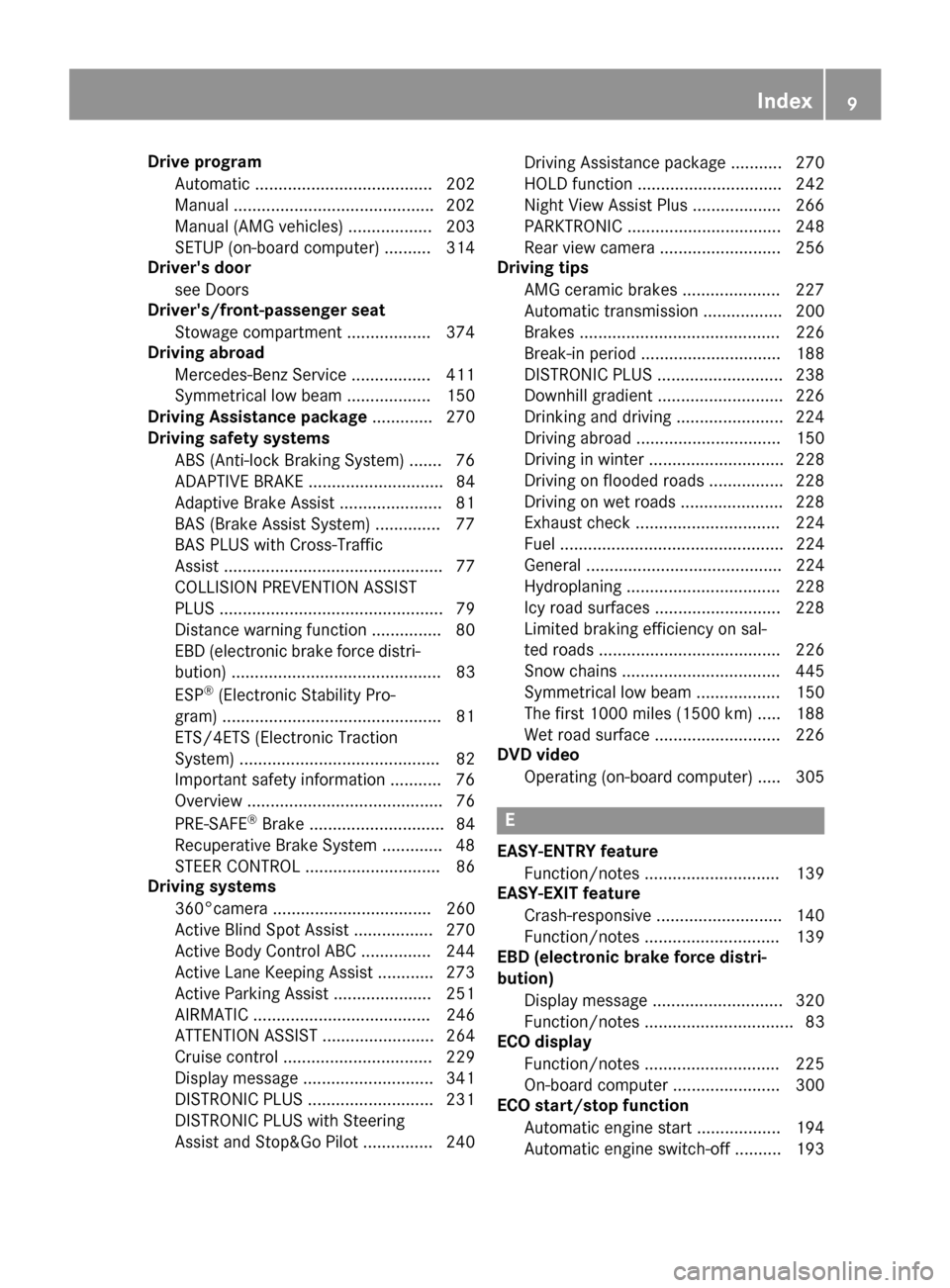
Drive program
Automatic ...................................... 202
Manual .......................................... .202
Manual (AMG vehicles) .................. 203
SETUP (on-board computer) .......... 314
Driver's door
see Doors
Driver's/front-passenger seat
Stowage compartment .................. 374
Driving abroad
Mercedes-Benz Service ................. 411
Symmetrical low bea m.................. 150
Driving Assistance package ............. 270
Driving safety systems
ABS (Anti-lock Braking System) ....... 76
ADAPTIVE BRAK E............................. 84
Adaptive Brake Assist ...................... 81
BAS (Brake Assist System) .............. 77
BAS PLUS with Cross-Traffic
Assist ............................................... 77
COLLISION PREVENTION ASSIST
PLUS ................................................ 79
Distance warning function ............... 80
EBD (electronic brake force distri- bution) ............................................. 83
ESP ®
(Electronic Stability Pro-
gram) ............................................... 81
ETS/4ETS (Electronic Traction
System) ........................................... 82
Important safety information ........... 76
Overview .......................................... 76
PRE-SAFE ®
Brake ............................. 84
Recuperative Brake System ............. 48
STEER CONTROL ............................. 86
Driving systems
360°camera .................................. 260
Active Blind Spot Assist ................. 270
Active Body Control ABC ............... 244
Active Lane Keeping Assist ............ 273
Active Parking Assist ..................... 251
AIRMATIC ...................................... 246
ATTENTION ASSIST ........................ 264
Cruise control ................................ 229
Display message ............................ 341
DISTRONIC PLUS ........................... 231
DISTRONIC PLUS with Steering
Assist and Stop&Go Pilot ............... 240 Driving Assistance packag
e........... 270
HOLD function ............................... 242
Night View Assist Plus ................... 266
PARKTRONIC ................................. 248
Rear view camera .......................... 256
Driving tips
AMG ceramic brakes ..................... 227
Automatic transmission ................. 200
Brakes ........................................... 226
Break-in period .............................. 188
DISTRONIC PLUS ........................... 238
Downhill gradient ........................... 226
Drinking and driving ....................... 224
Driving abroad ............................... 150
Driving in winter ............................. 228
Driving on flooded roads ................ 228
Driving on wet roads ...................... 228
Exhaust check ............................... 224
Fuel ................................................ 224
General .......................................... 224
Hydroplaning ................................. 228
Icy road surfaces ........................... 228
Limited braking efficiency on sal-
ted roads ....................................... 226
Snow chains .................................. 445
Symmetrical low beam .................. 150
The first 1000 miles (1500 km) ..... 188
Wet road surface ........................... 226
DVD video
Operating (on-board computer) ..... 305 E
EASY-ENTRY feature Function/note s............................. 139
EASY-EXIT feature
Crash-responsive ........................... 140
Function/note s............................. 139
EBD (electronic brake force distri-
bution)
Display message ............................ 320
Function/note s................................ 83
ECO display
Function/note s............................. 225
On-board computer ....................... 300
ECO start/stop function
Automatic engine start .................. 194
Automatic engine switch-off .......... 193 Index
9
Page 24 of 502
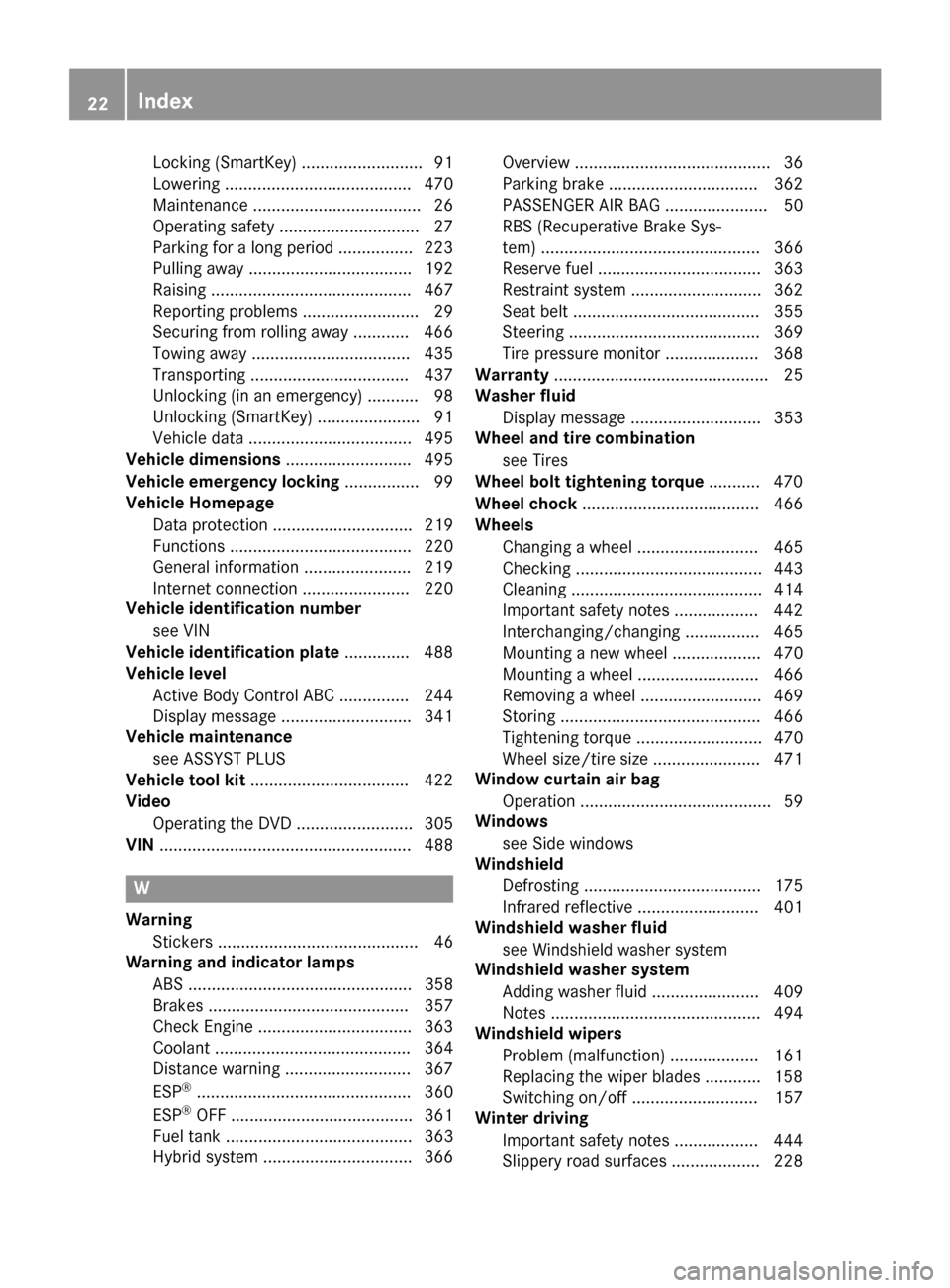
Locking (SmartKey) .......................... 91
Lowering ........................................ 470
Maintenance .................................... 26
Operating safety .............................. 27
Parking for a long period ................ 223
Pulling away ................................... 192
Raising ........................................... 467
Reporting problems ......................... 29
Securing from rolling away ............ 466
Towing away .................................. 435
Transporting .................................. 437
Unlocking (in an emergency) ........... 98
Unlocking (SmartKey) ...................... 91
Vehicle data ................................... 495
Vehicle dimensions ........................... 495
Vehicle emergency locking ................ 99
Vehicle Homepage
Data protection .............................. 219
Functions ....................................... 220
General information ....................... 219
Internet connection ....................... 220
Vehicle identification number
see VIN
Vehicle identification plate .............. 488
Vehicle level
Active Body Control ABC ............... 244
Display message ............................ 341
Vehicle maintenance
see ASSYST PLUS
Vehicle tool kit .................................. 422
Video
Operating the DVD ......................... 305
VIN ...................................................... 488 W
Warning Stickers ........................................... 46
Warning and indicator lamps
ABS ................................................ 358
Brakes ........................................... 357
Check Engine ................................. 363
Coolant .......................................... 364
Distance warning ........................... 367
ESP ®
.............................................. 360
ESP ®
OFF ....................................... 361
Fuel tank ........................................ 363
Hybrid system ................................ 366 Overview .......................................... 36
Parking brake ................................ 362
PASSENGER AIR BAG ...................... 50
RBS (Recuperative Brake Sys-
tem) ............................................... 366
Reserve fue
l................................... 363
Restraint system ............................ 362
Seat belt ........................................ 355
Steering ......................................... 369
Tire pressure monitor .................... 368
Warranty .............................................. 25
Washer fluid
Display message ............................ 353
Wheel and tire combination
see Tires
Wheel bolt tightening torque ........... 470
Wheel chock ...................................... 466
Wheels
Changing a whee l.......................... 465
Checking ........................................ 443
Cleaning ......................................... 414
Important safety notes .................. 442
Interchanging/changing ................ 465
Mounting a new whee l................... 470
Mounting a whee l.......................... 466
Removing a whee l.......................... 469
Storing ........................................... 466
Tightening torque ........................... 470
Wheel size/tire size ....................... 471
Window curtain air bag
Operation ......................................... 59
Windows
see Side windows
Windshield
Defrosting ...................................... 175
Infrared reflective .......................... 401
Windshield washer fluid
see Windshield washer system
Windshield washer system
Adding washer fluid ....................... 409
Notes ............................................. 494
Windshield wipers
Problem (malfunction) ................... 161
Replacing the wiper blades ............ 158
Switching on/of f........................... 157
Winter driving
Important safety notes .................. 444
Slippery road surfaces ................... 228 22
Index
Page 26 of 502
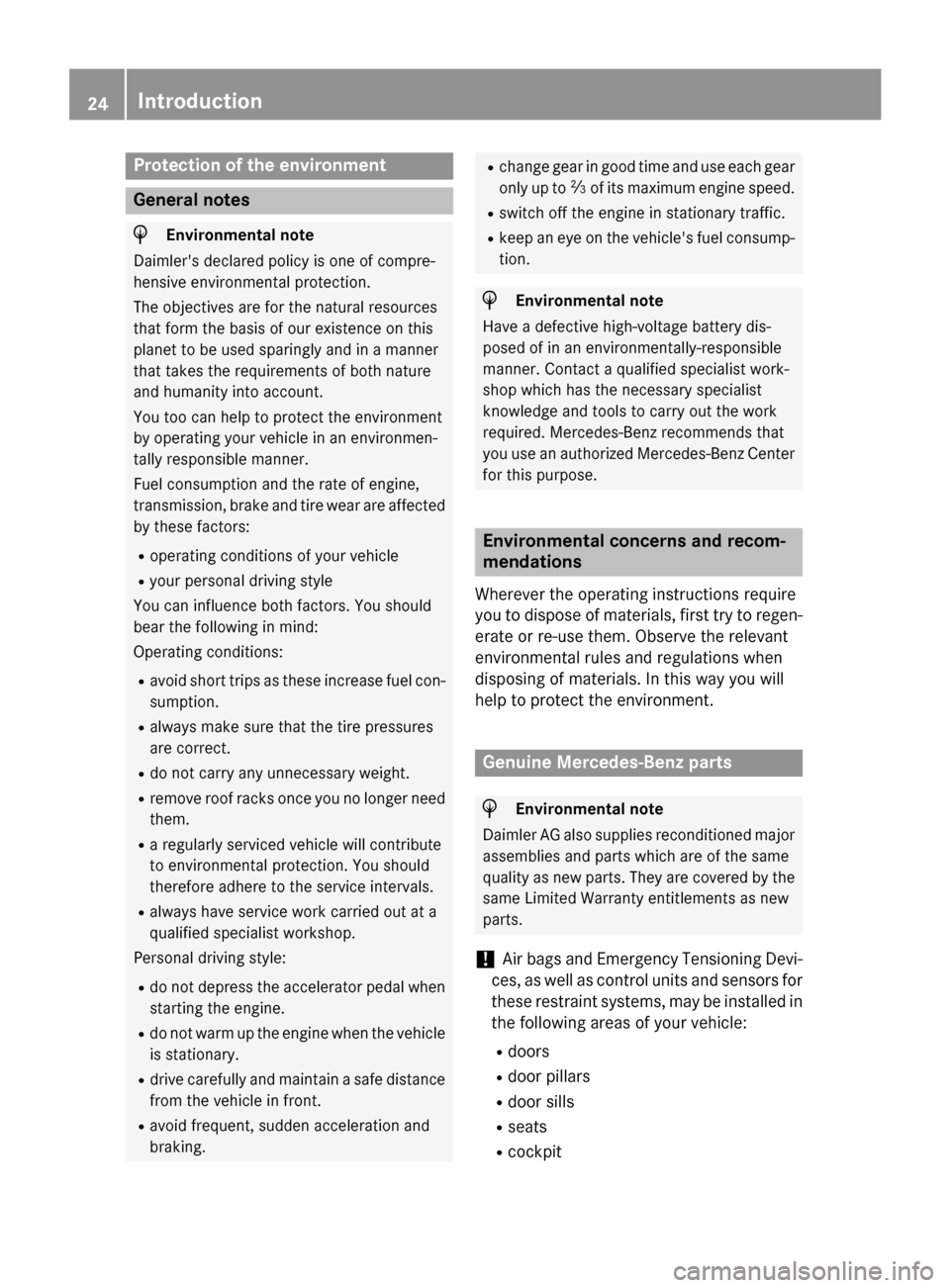
Protection of the environment
General notes
H
Environmental note
Daimler's declared policy is one of compre-
hensive environmental protection.
The objectives are for the natural resources
that form the basis of our existence on this
planet to be used sparingly and in a manner
that takes the requirements of both nature
and humanity into account.
You too can help to protect the environment
by operating your vehicle in an environmen-
tally responsible manner.
Fuel consumption and the rate of engine,
transmission, brake and tire wear are affected by these factors:
R operating conditions of your vehicle
R your personal driving style
You can influence both factors. You should
bear the following in mind:
Operating conditions:
R avoid short trips as these increase fuel con-
sumption.
R always make sure that the tire pressures
are correct.
R do not carry any unnecessary weight.
R remove roof racks once you no longer need
them.
R a regularly serviced vehicle will contribute
to environmental protection. You should
therefore adhere to the service intervals.
R always have service work carried out at a
qualified specialist workshop.
Personal driving style:
R do not depress the accelerator pedal when
starting the engine.
R do not warm up the engine when the vehicle
is stationary.
R drive carefully and maintain a safe distance
from the vehicle in front.
R avoid frequent, sudden acceleration and
braking. R
change gear in good time and use each gear
only up to Ôof its maximum engine speed.
R switch off the engine in stationary traffic.
R keep an eye on the vehicle's fuel consump-
tion. H
Environmental note
Have a defective high-voltage battery dis-
posed of in an environmentally-responsible
manner. Contact a qualified specialist work-
shop which has the necessary specialist
knowledge and tools to carry out the work
required. Mercedes-Benz recommends that
you use an authorized Mercedes-Benz Center
for this purpose. Environmental concerns and recom-
mendations
Wherever the operating instructions require
you to dispose of materials, first try to regen-
erate or re-use them. Observe the relevant
environmental rules and regulations when
disposing of materials. In this way you will
help to protect the environment. Genuine Mercedes-Benz parts
H
Environmental note
Daimler AG also supplies reconditioned major
assemblies and parts which are of the same
quality as new parts. They are covered by the same Limited Warranty entitlements as new
parts.
! Air bags and Emergency Tensioning Devi-
ces, as well as control units and sensors for
these restraint systems, may be installed in the following areas of your vehicle:
R doors
R door pillars
R door sills
R seats
R cockpit 24
Introduction
Page 38 of 502
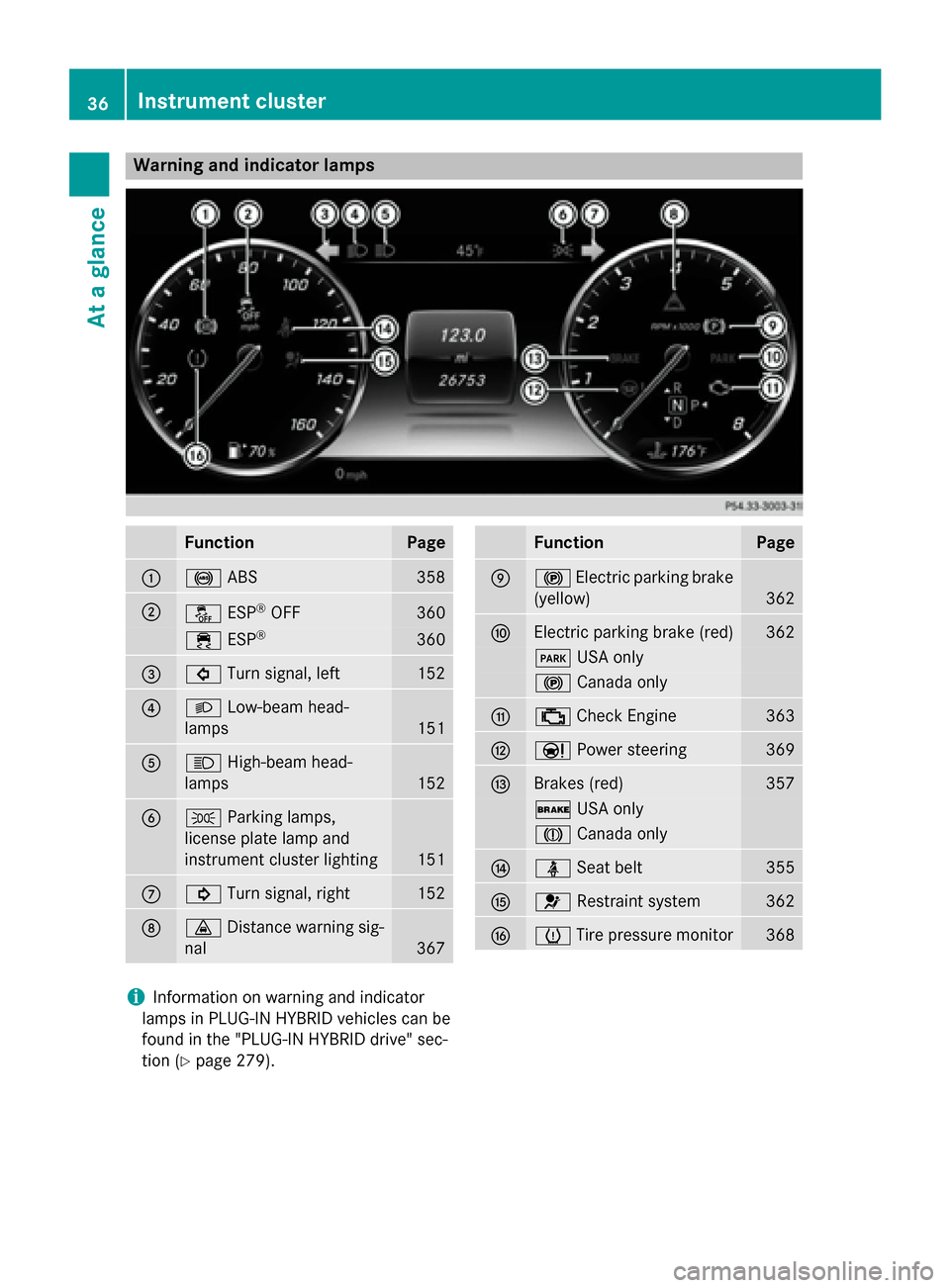
Warning and indicator lamps
Function Page
:
!
ABS 358
;
å
ESP®
OFF 360
÷
ESP® 360
=
#
Turn signal, left 152
?
L
Low-beam head-
lamps 151
A
K
High-beam head-
lamps 152
B
T
Parking lamps,
license plate lamp and
instrument cluster lighting 151
C
!
Turn signal, right 152
D
·
Distance warning sig-
nal 367 Function Page
E
!
Electric parking brake
(yellow) 362
F
Electric parking brake (red) 362
F
USA only !
Canada only G
;
Check Engine 363
H
Ð
Power steering 369
I
Brakes (red) 357
$
USA only J
Canada only J
ü
Seat belt 355
K
6
Restraint system 362
L
h
Tire pressure monitor 368
i
Information on warning and indicator
lamps in PLUG-IN HYBRID vehicles can be
found in the "PLUG-IN HYBRID drive" sec-
tion (Y page 279). 36
Instrument clusterAt a glance
Page 50 of 502
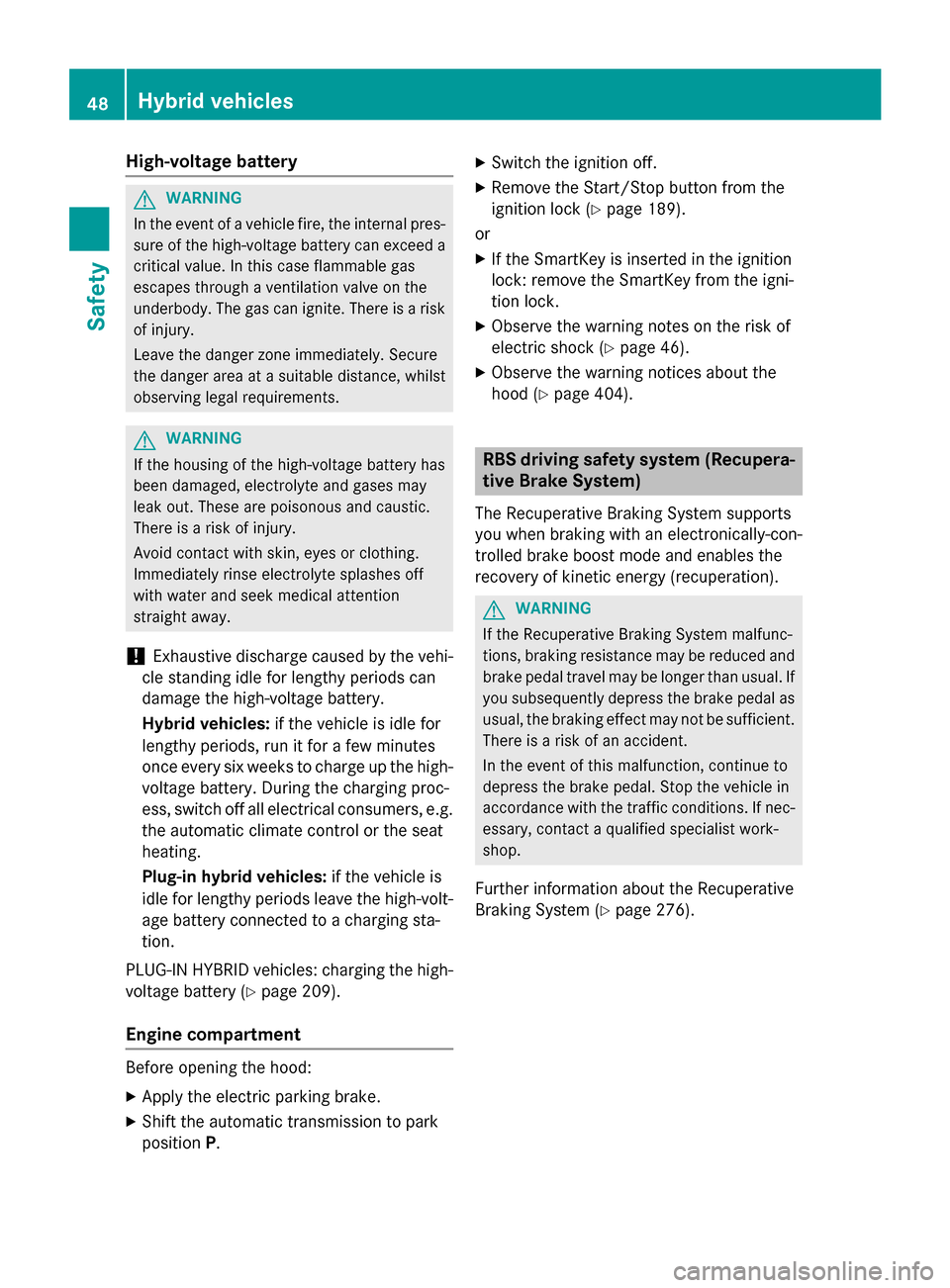
High-voltage battery
G
WARNING
In the event of a vehicle fire, the internal pres- sure of the high-voltage battery can exceed a
critical value. In this case flammable gas
escapes through a ventilation valve on the
underbody. The gas can ignite. There is a risk of injury.
Leave the danger zone immediately. Secure
the danger area at a suitable distance, whilst
observing legal requirements. G
WARNING
If the housing of the high-voltage battery has
been damaged, electrolyte and gases may
leak out. These are poisonous and caustic.
There is a risk of injury.
Avoid contact with skin, eyes or clothing.
Immediately rinse electrolyte splashes off
with water and seek medical attention
straight away.
! Exhaustive discharge caused by the vehi-
cle standing idle for lengthy periods can
damage the high-voltage battery.
Hybrid vehicles: if the vehicle is idle for
lengthy periods, run it for a few minutes
once every six weeks to charge up the high- voltage battery. During the charging proc-
ess, switch off all electrical consumers, e.g.
the automatic climate control or the seat
heating.
Plug-in hybrid vehicles: if the vehicle is
idle for lengthy periods leave the high-volt- age battery connected to a charging sta-
tion.
PLUG-IN HYBRID vehicles: charging the high-
voltage battery (Y page 209).
Engine compartment Before opening the hood:
X Apply the electric parking brake.
X Shift the automatic transmission to park
position P. X
Switch the ignition off.
X Remove the Start/Stop button from the
ignition lock (Y page 189).
or X If the SmartKey is inserted in the ignition
lock: remove the SmartKey from the igni-
tion lock.
X Observe the warning notes on the risk of
electric shock (Y page 46).
X Observe the warning notices about the
hood (Y page 404). RBS driving safety system (Recupera-
tive Brake System)
The Recuperative Braking System supports
you when braking with an electronically-con-
trolled brake boost mode and enables the
recovery of kinetic energy (recuperation). G
WARNING
If the Recuperative Braking System malfunc-
tions, braking resistance may be reduced and brake pedal travel may be longer than usual. If
you subsequently depress the brake pedal as usual, the braking effect may not be sufficient.
There is a risk of an accident.
In the event of this malfunction, continue to
depress the brake pedal. Stop the vehicle in
accordance with the traffic conditions. If nec-
essary, contact a qualified specialist work-
shop.
Further information about the Recuperative
Braking System (Y page 276).48
Hybrid vehiclesSafety
Page 58 of 502
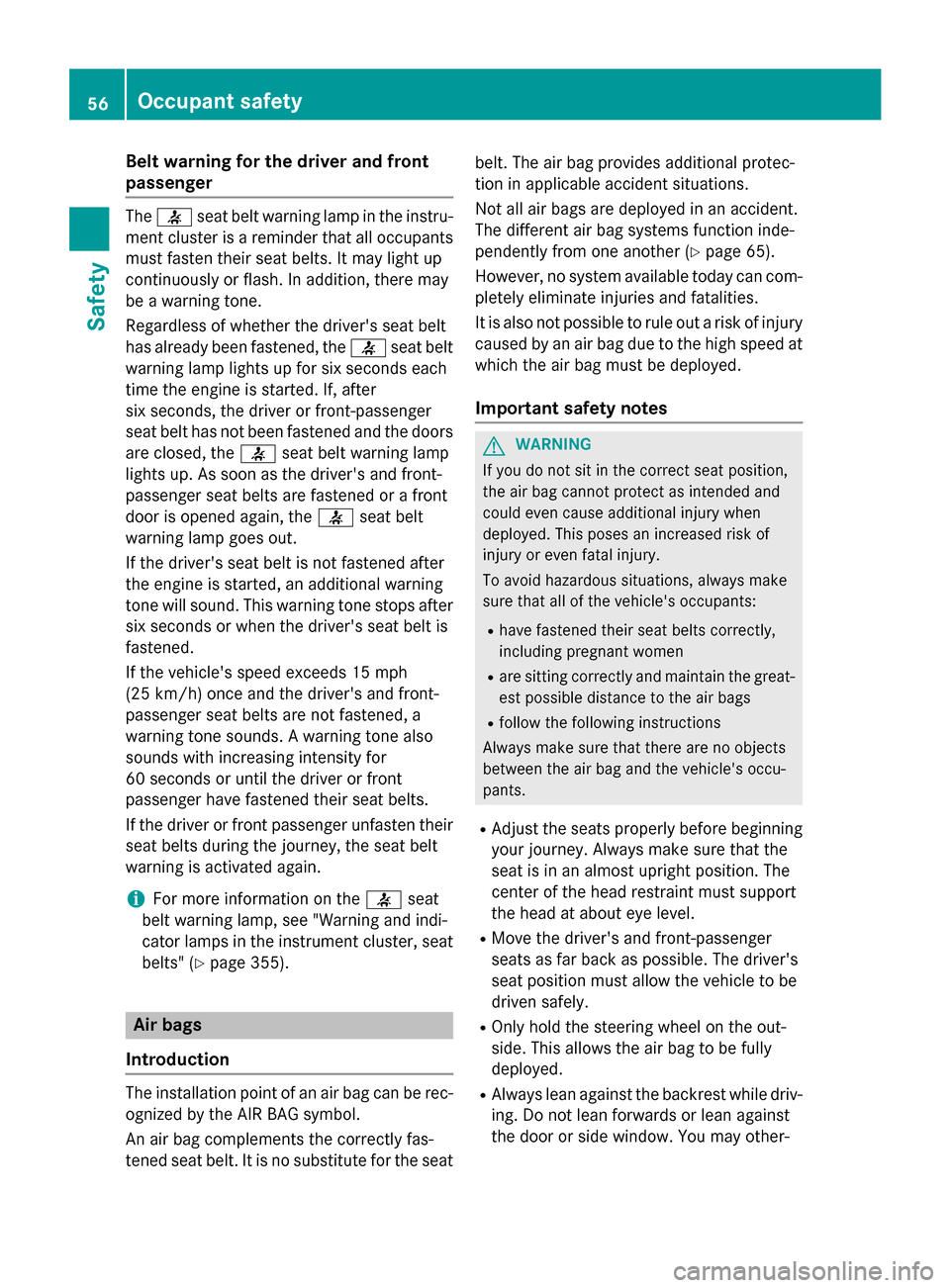
Belt warning for the driver and front
passenger The
7 seat belt warning lamp in the instru-
ment cluster is a reminder that all occupants
must fasten their seat belts. It may light up
continuously or flash. In addition, there may
be a warning tone.
Regardless of whether the driver's seat belt
has already been fastened, the 7seat belt
warning lamp lights up for six seconds each
time the engine is started. If, after
six seconds, the driver or front-passenger
seat belt has not been fastened and the doors
are closed, the 7seat belt warning lamp
lights up. As soon as the driver's and front-
passenger seat belts are fastened or a front
door is opened again, the 7seat belt
warning lamp goes out.
If the driver's seat belt is not fastened after
the engine is started, an additional warning
tone will sound. This warning tone stops after six seconds or when the driver's seat belt is
fastened.
If the vehicle's speed exceeds 15 mph
(25 km/h) once and the driver's and front-
passenger seat belts are not fastened, a
warning tone sounds. A warning tone also
sounds with increasing intensity for
60 seconds or until the driver or front
passenger have fastened their seat belts.
If the driver or front passenger unfasten their seat belts during the journey, the seat belt
warning is activated again.
i For more information on the
7seat
belt warning lamp, see "Warning and indi-
cator lamps in the instrument cluster, seat
belts" (Y page 355). Air bags
Introduction The installation point of an air bag can be rec-
ognized by the AIR BAG symbol.
An air bag complements the correctly fas-
tened seat belt. It is no substitute for the seat belt. The air bag provides additional protec-
tion in applicable accident situations.
Not all air bags are deployed in an accident.
The different air bag systems function inde-
pendently from one another (Y page 65).
However, no system available today can com- pletely eliminate injuries and fatalities.
It is also not possible to rule out a risk of injury
caused by an air bag due to the high speed at which the air bag must be deployed.
Important safety notes G
WARNING
If you do not sit in the correct seat position,
the air bag cannot protect as intended and
could even cause additional injury when
deployed. This poses an increased risk of
injury or even fatal injury.
To avoid hazardous situations, always make
sure that all of the vehicle's occupants:
R have fastened their seat belts correctly,
including pregnant women
R are sitting correctly and maintain the great-
est possible distance to the air bags
R follow the following instructions
Always make sure that there are no objects
between the air bag and the vehicle's occu-
pants.
R Adjust the seats properly before beginning
your journey. Always make sure that the
seat is in an almost upright position. The
center of the head restraint must support
the head at about eye level.
R Move the driver's and front-passenger
seats as far back as possible. The driver's
seat position must allow the vehicle to be
driven safely.
R Only hold the steering wheel on the out-
side. This allows the air bag to be fully
deployed.
R Always lean against the backrest while driv-
ing. Do not lean forwards or lean against
the door or side window. You may other- 56
Occupant safetySafety
Page 78 of 502
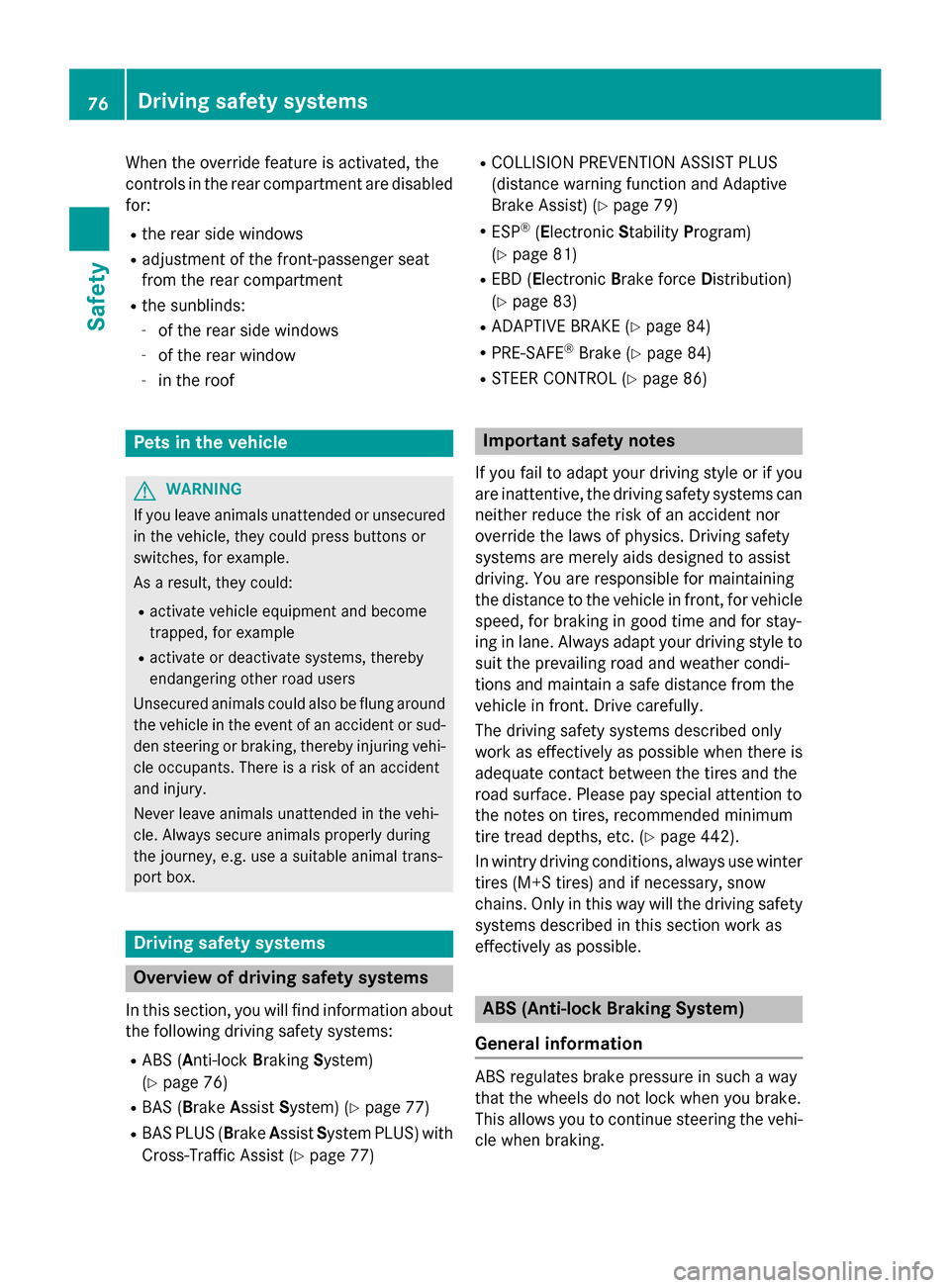
When the override feature is activated, the
controls in the rear compartment are disabled
for:
R the rear side windows
R adjustment of the front-passenger seat
from the rear compartment
R the sunblinds:
- of the rear side windows
- of the rear window
- in the roof Pets in the vehicle
G
WARNING
If you leave animals unattended or unsecured in the vehicle, they could press buttons or
switches, for example.
As a result, they could:
R activate vehicle equipment and become
trapped, for example
R activate or deactivate systems, thereby
endangering other road users
Unsecured animals could also be flung around
the vehicle in the event of an accident or sud- den steering or braking, thereby injuring vehi-
cle occupants. There is a risk of an accident
and injury.
Never leave animals unattended in the vehi-
cle. Always secure animals properly during
the journey, e.g. use a suitable animal trans-
port box. Driving safety systems
Overview of driving safety systems
In this section, you will find information about the following driving safety systems:
R ABS (Anti-lock BrakingSystem)
(Y page 76)
R BAS ( Brake Assist System) (Y page 77)
R BAS PLUS (Brake AssistSystem PLUS) with
Cross-Traffic Assist (Y page 77)R
COLLISION PREVENTION ASSIST PLUS
(distance warning function and Adaptive
Brake Assist) (Y page 79)
R ESP ®
(Electronic StabilityProgram)
(Y page 81)
R EBD ( Electronic Brake force Distribution)
(Y page 83)
R ADAPTIVE BRAKE (Y page 84)
R PRE-SAFE ®
Brake (Y page 84)
R STEER CONTROL (Y page 86) Important safety notes
If you fail to adapt your driving style or if you
are inattentive, the driving safety systems can
neither reduce the risk of an accident nor
override the laws of physics. Driving safety
systems are merely aids designed to assist
driving. You are responsible for maintaining
the distance to the vehicle in front, for vehicle
speed, for braking in good time and for stay-
ing in lane. Always adapt your driving style to
suit the prevailing road and weather condi-
tions and maintain a safe distance from the
vehicle in front. Drive carefully.
The driving safety systems described only
work as effectively as possible when there is
adequate contact between the tires and the
road surface. Please pay special attention to
the notes on tires, recommended minimum
tire tread depths, etc. (Y page 442).
In wintry driving conditions, always use winter
tires (M+S tires) and if necessary, snow
chains. Only in this way will the driving safety systems described in this section work as
effectively as possible. ABS (Anti-lock Braking System)
General information ABS regulates brake pressure in such a way
that the wheels do not lock when you brake.
This allows you to continue steering the vehi-
cle when braking. 76
Driving safety systemsSafety
Page 79 of 502
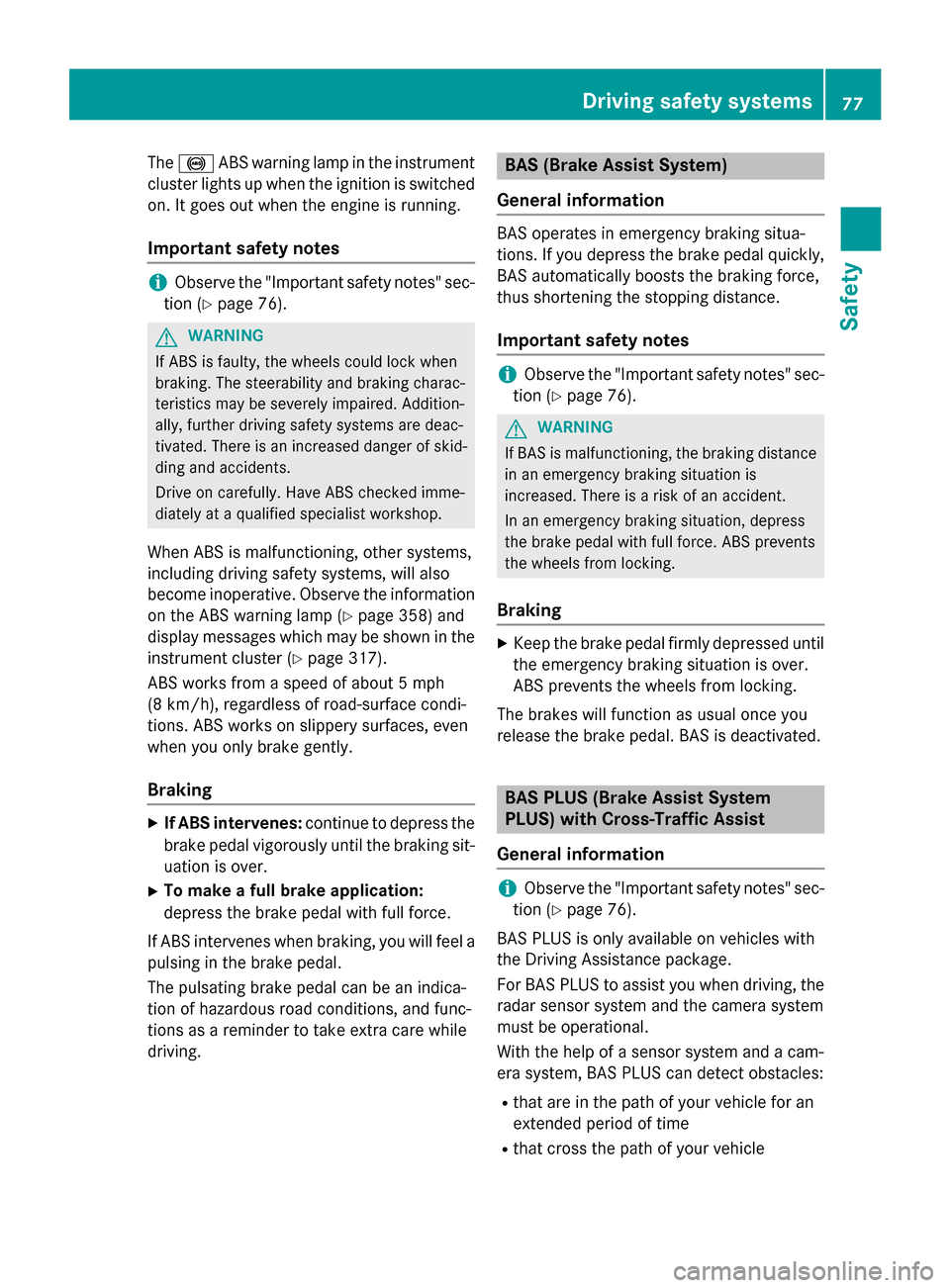
The
! ABS warning lamp in the instrument
cluster lights up when the ignition is switched on. It goes out when the engine is running.
Important safety notes i
Observe the "Important safety notes" sec-
tion (Y page 76). G
WARNING
If ABS is faulty, the wheels could lock when
braking. The steerability and braking charac-
teristics may be severely impaired. Addition-
ally, further driving safety systems are deac-
tivated. There is an increased danger of skid- ding and accidents.
Drive on carefully. Have ABS checked imme-
diately at a qualified specialist workshop.
When ABS is malfunctioning, other systems,
including driving safety systems, will also
become inoperative. Observe the information on the ABS warning lamp (Y page 358) and
display messages which may be shown in the
instrument cluster (Y page 317).
ABS works from a speed of about 5 mph
(8 km/h) , regardless of road-surface condi-
tions. ABS works on slippery surfaces, even
when you only brake gently.
Braking X
If ABS intervenes: continue to depress the
brake pedal vigorously until the braking sit- uation is over.
X To make a full brake application:
depress the brake pedal with full force.
If ABS intervenes when braking, you will feel a pulsing in the brake pedal.
The pulsating brake pedal can be an indica-
tion of hazardous road conditions, and func-
tions as a reminder to take extra care while
driving. BAS (Brake Assist System)
General information BAS operates in emergency braking situa-
tions. If you depress the brake pedal quickly,
BAS automatically boosts the braking force,
thus shortening the stopping distance.
Important safety notes i
Observe the "Important safety notes" sec-
tion (Y page 76). G
WARNING
If BAS is malfunctioning, the braking distance
in an emergency braking situation is
increased. There is a risk of an accident.
In an emergency braking situation, depress
the brake pedal with full force. ABS prevents
the wheels from locking.
Braking X
Keep the brake pedal firmly depressed until
the emergency braking situation is over.
ABS prevents the wheels from locking.
The brakes will function as usual once you
release the brake pedal. BAS is deactivated. BAS PLUS (Brake Assist System
PLUS) with Cross-Traffic Assist
General information i
Observe the "Important safety notes" sec-
tion (Y page 76).
BAS PLUS is only available on vehicles with
the Driving Assistance package.
For BAS PLUS to assist you when driving, the radar sensor system and the camera system
must be operational.
With the help of a sensor system and a cam-
era system, BAS PLUS can detect obstacles:
R that are in the path of your vehicle for an
extended period of time
R that cross the path of your vehicle Driving safety systems
77Safety Z
Page 81 of 502
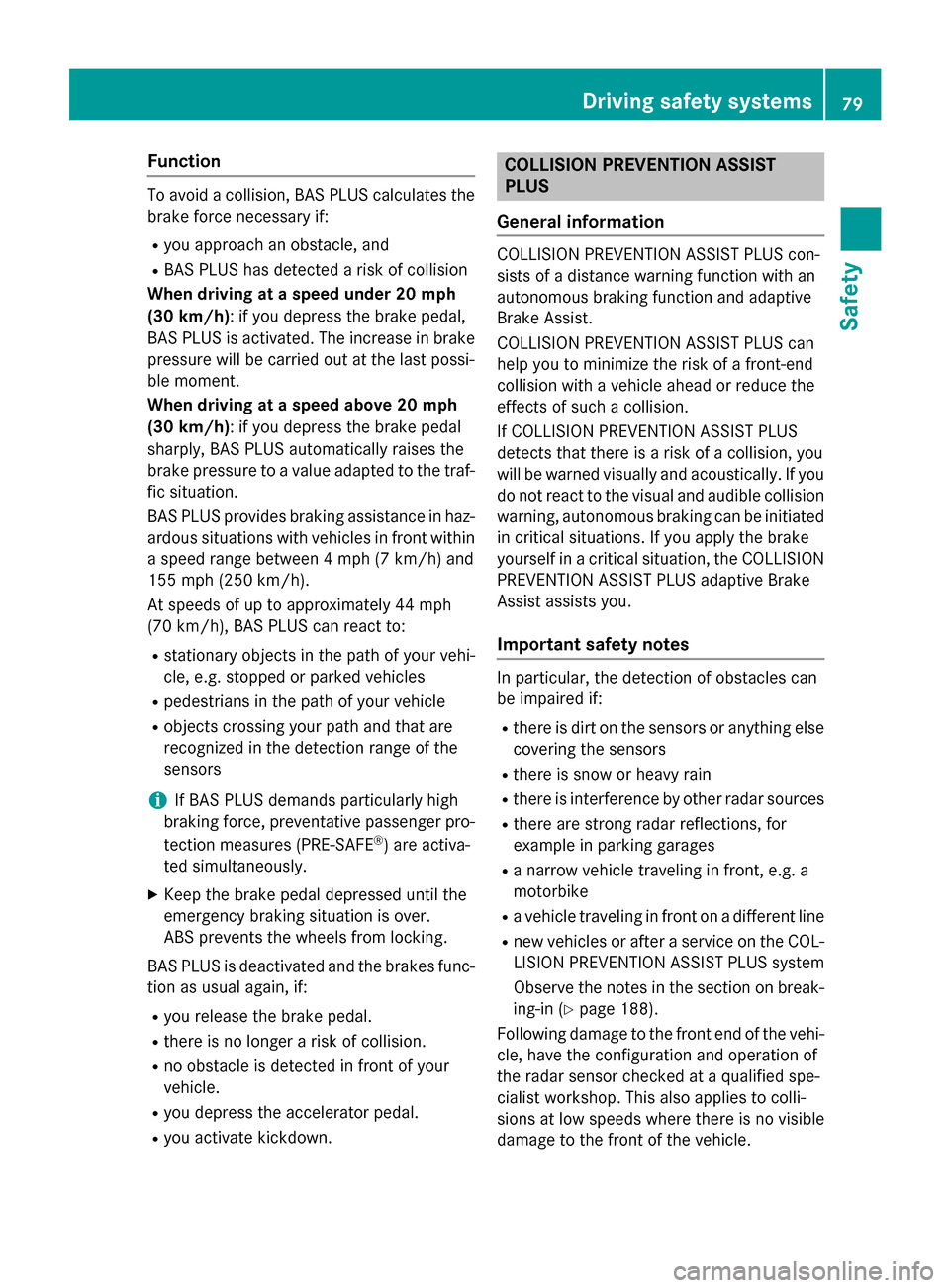
Function
To avoid a collision, BAS PLUS calculates the
brake force necessary if:
R you approach an obstacle, and
R BAS PLUS has detected a risk of collision
When driving at a speed under 20 mph
(30 km/h) : if you depress the brake pedal,
BAS PLUS is activated. The increase in brake pressure will be carried out at the last possi-
ble moment.
When driving at a speed above 20 mph
(30 km/h) : if you depress the brake pedal
sharply, BAS PLUS automatically raises the
brake pressure to a value adapted to the traf-
fic situation.
BAS PLUS provides braking assistance in haz- ardous situations with vehicles in front within
a speed range between 4 mph (7 km/h) and
155 mph (250 km/h).
At speeds of up to approximately 44 mph
(70 km/ h), BAS PLUS can react to:
R stationary objects in the path of your vehi-
cle, e.g. stopped or parked vehicles
R pedestrians in the path of your vehicle
R objects crossing your path and that are
recognized in the detection range of the
sensors
i If BAS PLUS demands particularly high
braking force, preventative passenger pro-
tection measures (PRE-SAFE ®
) are activa-
ted simultaneously.
X Keep the brake pedal depressed until the
emergency braking situation is over.
ABS prevents the wheels from locking.
BAS PLUS is deactivated and the brakes func-
tion as usual again, if:
R you release the brake pedal.
R there is no longer a risk of collision.
R no obstacle is detected in front of your
vehicle.
R you depress the accelerator pedal.
R you activate kickdown. COLLISION PREVENTION ASSIST
PLUS
General information COLLISION PREVENTION ASSIST PLUS con-
sists of a distance warning function with an
autonomous braking function and adaptive
Brake Assist.
COLLISION PREVENTION ASSIST PLUS can
help you to minimize the risk of a front-end
collision with a vehicle ahead or reduce the
effects of such a collision.
If COLLISION PREVENTION ASSIST PLUS
detects that there is a risk of a collision, you
will be warned visually and acoustically. If you do not react to the visual and audible collision
warning, autonomous braking can be initiated in critical situations. If you apply the brake
yourself in a critical situation, the COLLISION PREVENTION ASSIST PLUS adaptive Brake
Assist assists you.
Important safety notes In particular, the detection of obstacles can
be impaired if:
R there is dirt on the sensors or anything else
covering the sensors
R there is snow or heavy rain
R there is interference by other radar sources
R there are strong radar reflections, for
example in parking garages
R a narrow vehicle traveling in front, e.g. a
motorbike
R a vehicle traveling in front on a different line
R new vehicles or after a service on the COL-
LISION PREVENTION ASSIST PLUS system
Observe the notes in the section on break-
ing-in (Y page 188).
Following damage to the front end of the vehi- cle, have the configuration and operation of
the radar sensor checked at a qualified spe-
cialist workshop. This also applies to colli-
sions at low speeds where there is no visible
damage to the front of the vehicle. Driving safety systems
79Safety Z